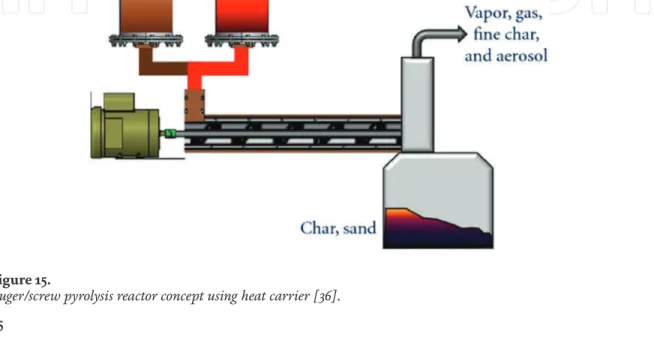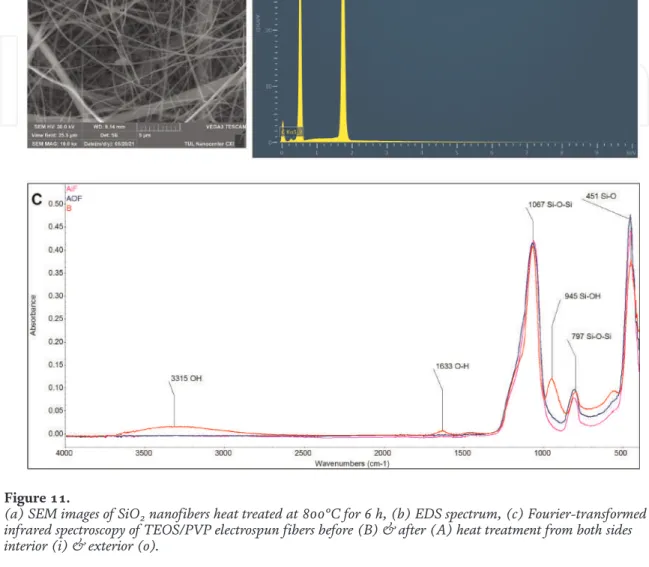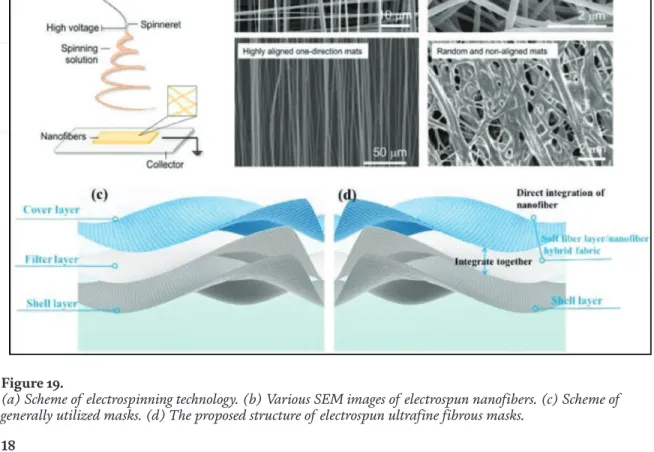Plans of a complex spinning net for performing trifluidic electrospinning: (a) digital image showing the overall view of the spinning drag; (b) front view; (c) side view; and (d) diagram on the organization of the structural outflow from the three inlets [17]. Most of the insoluble floral biomass is in the form of lignocellulosic and chitinous material.

Innovative waste biomass-sourced electrospun products
Biomedical product
In the biomedical field, literature reports on manufactured products made from electrospun biomass fibers range from drug delivery agents to biomaterials [42], wound dressings with antibacterial activity, face masks [45] and biomedical applications. for tissue regeneration as shown in Figure 18. As a result of the structure and bioactivity of the loaded pharmaceuticals remaining unchanged during the spinning process, electrospun agents for drug delivery attracted interest.
Renewable energy products
The lower performance can be attributed to the higher number of oxygen functional groups of the starting material. As a result, environmentally friendly biomass electrospun fibers with improved performance in operating electrochemical devices have shown that the fabrication of future smart energy storage materials will be ecologically viable, offering a completely green alternative to power transportation and conventional storage [50]. .
Electrical products
Conclusion and future works
Most of the insoluble floral biomass is in the form of lignocellulosic and chitinous material, while the soluble biomass is in the form of proteins and polysaccharides. Review of current advances in the properties and manufacturing process and possible applications for COVID-19. Electrospinning of PLGA/gelatin randomly oriented and aligned nanofibers as potential scaffold in tissue engineering.
Electrospinning of silk fibroin nanofibers and its effect on the adhesion and spreading of normal human keratinocytes and fibroblasts in vitro. Brazilian Archives of Biology and Technology Sustainable Management of Keratin Waste Biomass: Applications and Future Perspectives. Product yield, quality and energy in the hydrolysis of urban biowaste compost from laboratory-scale runs.
A selection of our books indexed in the Book Citation Index in the Web of Science™ Core Collection (BKCI).
TOP 1%
Introduction
The modern paradigm of targeted delivery of drugs to the organ of interest, its part or the target cell is based on the use of biocompatible carriers whose sizes are in the submicron (nanometer) range. Today, functional carriers of biologically active compounds and adsorbents with a high specific surface area are widely used in medicine in the form of bioceramic minerals, polymeric therapeutic systems, framework structures for cell engineering, nanoscale hybrid vehicles for targeted drug delivery, and a number of innovative systems that work simultaneously as. Among these functional materials, the greatest practical and commercial advantages, in the near future, will be.
Micro- and nanoparticles based on biodegradable materials offer a wide range of applications as components of innovative forms or independent systems for drug delivery in the implementation of anti-inflammatory and antitumor therapy, wound healing and thrombolytic therapy. The use of biodegradable and biocompatible particles and fibers creates additional advantages in the development of a new generation of implanted therapeutic systems. Fibrillar matrices and mats formed by the obtained nanofibers create favorable conditions for free migration and proliferation of cells in the three-dimensional space of frame structures, and consequently provide a high integration affinity of the material for living tissues of the body [15].
They are actively used in the design of biosensors, nanofilters, for wound therapy, to immobilize enzymes, in the creation of extended and targeted drug delivery systems and other fields of modern biology and medicine [16-20].
Fields of application of biopolymer forms for therapeutic purposes Biodegradable compositions are also applied in solving the problem of wound
Materials in the form of films, hydrogels, foams, multilayer composites, etc., have already been used clinically. Much attention is now being paid to the development of composite hydrogels for injections—research is being carried out using photopolymerization, chemical cross-linking of molecules in the composition of the composite with carbodiimide, glutaraldehyde, genipin and adipic dihydrazide. In the first case, the use of a photosensitizer and radiation is required, which limits the applicability of the approach, and in the case of.
In this study, the high content of chitosan led to a decrease in the degradation rate of the composite. Let's look at several examples of the use of composite particles based on biodegradable polymers. The formation of complexes between enzymes and biodegradable polymers proved to be an effective way to overcome the short biological half-life of enzymes in the bloodstream, and the inclusion of magnetic cores in the particles revealed the potential of using biodegradable materials for drug targeting. transport and diagnostics.
Biodegradable innovative materials have thus received a wide range of possible applications in the treatment of various diseases (Figure 1) in the form of various medical forms—macroobjects, films, micro- and nanoparticles, etc.
The main components of biodegradable innovative forms of drug delivery
The positive charge of chitosan also promotes adhesion to the body's mucous membranes, making it possible to use it to transport drugs through the mucosa. The combination of natural and synthetic materials in the compositions provides a wide range of properties of the systems and the possibilities of their use. In this case, the drugs themselves can be covalently and non-covalently linked to biodegradable compositions, in particular, the inclusion of drugs in the composition of Ca3(PO4)2 particles is carried out physically or chemically [24], and the release of drugs can is controlled by the chemistry of Ca3(PO4)2, the porosity of the material, the surface area of the hydrogel particles, their charge surface and.
In the case of covalent immobilization of macromolecular pharmaceuticals (for example, proteins), the release mechanism involves chemical/enzymatic cleavage of the active substance. The introduction of an antibiotic in the treatment of osteomyelitis can be provided by directly mixing the herb powder with a bone graft or soaking the bone graft in an antibiotic solution [26]. Incorporating pharmaceutical products into structures composed of a solution after their creation is one of the least damaging approaches to pharmaceuticals.
Most of the listed approaches for drug incorporation into various matrices can also be implemented when nanoparticles are incorporated into hydrogels.
Structure and morphology of ultrathin fibers as drug carriers
- Influence of dipyridamole (DPD) on the structure and segmental mobility of a biopolymer in ultrathin fibers
- Influence of thermal heating of PHB fibers containing a dipyridamole on the molecular dynamics of polymer chains
As the concentration of the dense fraction in the intercrystalline regions of PHB increases, a corresponding decrease in the rotation rate of the radical is observed, and, therefore, the segmental mobility of macromolecules slows down. Consequently, a change in the crystalline phase of the polymer affects the dynamics of the chains in the denser regions of the intercrystalline space and practically does not affect the fast component of their mobility in the less dense intercrystalline regions. These results can be explained within the framework of the heterogeneous (binary) structure model.
Indeed, fragments of the polymer chain with a predominance of directed conformation are mainly involved in the formation of precrystalline regions and recrystallization of the polymer. The imperfection of the crystalline phase and morphology is manifested in the insufficient orientation of the segments in the fiber, as well as in an atypical low degree of crystallinity [63]. As a result, the absorption capacity of the fiber due to an increase in the degree of crystallinity.
Indeed, measurements of the concentration of a stable radical in the fibers also show a sharp decrease in this value after baking for 2 hours.
Diffusion and controlled drug release in ultrathin PHB fibers and fibrillar films based on them
With this formulation of the problem, the kinetic profile of drug release is described by the following system of equations. During the time interval Δt, the cumulative mass of the drug is released from the fibrillar film by time t (ΔMd(t)). Taking into account the introduced correlation of the diffusion path length in the water phase, and also taking into account the correction for the degree of.
This is not universal, since with an increase in the volume of the interfibrillar space of the system, that is, the last line of Table 2 shows the constants of the drug yield due to the loss of fiber mass during hydrolysis (kh). It can also be noted here that the rate of hydrolysis decreases with an increase in the crystallinity of the fiber and the lower, the higher the concentration of the drug in the fiber.
The totality of the results known in the literature and presented in this chapter allows us to draw two conclusions.
Conclusion
Calcium Phosphate Ceramic Systems in Growth Factor and Drug Delivery for Bone Tissue Engineering: An Overview. In situ formation of injectable chitosan-gelatin hydrogels by double cross-linking for sustained intraocular drug delivery. Molecular dynamics of the spin probes in dry and wet poly(3-hydroxybutyrate) films with different morphology.
The compactness and sensitivity of the sensors have been significantly improved by the original hybrid fiberglass/nanofiber design. The potential of the new detection principle for different applications (biomedical, chemical, forensic, automotive, etc.) will be discussed. The potential difference depended on the properties of the solution, such as the molecular weight of the polymer and the viscosity.
If the molecular cohesion of the liquid is sufficiently high, a charged jet will be formed; otherwise drops are electrosprays.
Electrospinning and sensors
Transduction sensing mechanisms
- Capacitive sensors based on electrospun nanofibers
- Resistive sensors based on electrospun nanofibers
- Fiber optic sensors
The resistance of the metal oxide changes in accordance with the adsorption of the gases. Moreover, doping is an effective method to improve the sensing properties of the sensors. Sensing mechanism of MOS gas sensors: (a) in clean air and (b) in the presence of the target gas.
The results of these experiments are very optimistic about the effectiveness of the described nanofiber optical fiber system. Also, the functionalization of fibers with elements that attract bacteria will be implemented in future works. This is probably related to water molecules being absorbed and concentrated in the pores of the silica nanofibers.
This effect will change the refractive index (RI) of the silica nanofibers, thus changing the optical power intensity.

Conclusion
The experiments are still ongoing as humidity and temperature are monitored to map the parameters, which can affect the accuracy and repeatability of the potential sensor. This chapter is distributed under the terms of the Creative Commons Attribution License (http://creativecommons.org/licenses/by/3.0), which permits unrestricted use, distribution, and reproduction in any medium, provided the original work is properly cited . Preparation of nitrogen-doped TiO2 nanofibers using Near Field Electrospinning (NFES) technique for NO2 detection.
Highly porous SnO2 fibers by electrospinning and oxygen plasma etching and its ethanol-sensing properties. Functionalized Nanofibers as Sensor Materials for Fiber Optic Sensors, Nanofibers, Applications and Related Technologies - NART 2017.
